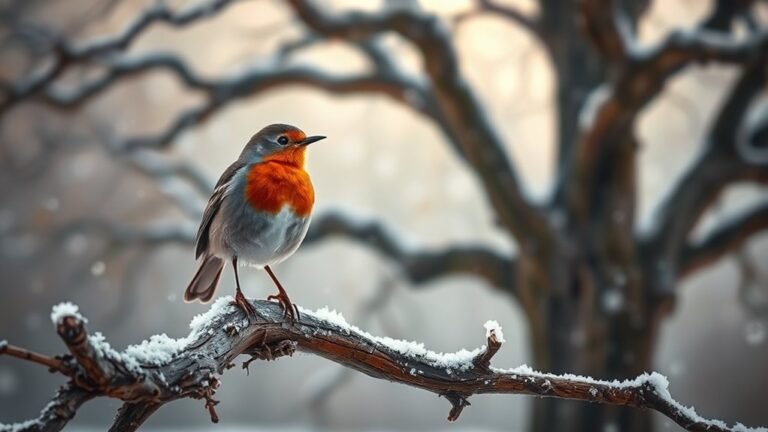Aerial, Terrestrial, and Arboreal Bird Species Explained
Bird species categorize into aerial, terrestrial, and arboreal groups based on their adaptations. Each group has specific characteristics suited to their environments. Aerial birds excel in flight, which helps them find food and escape predators. Terrestrial birds thrive on the ground, using their legs to run and forage. Arboreal birds live in trees, where they nest and find shelter.
These adaptations affect how birds interact with their surroundings. Aerial birds might help pollinate plants or spread seeds as they fly. Terrestrial birds can manage insects and small animals on the ground, while arboreal birds contribute to the health of tree ecosystems. Understanding these roles clarifies how each group supports its habitat and ecosystem.
Key Takeaways
- Aerial birds, like raptors, use soaring and gliding techniques to hunt, relying on sharp eyesight to locate prey from distances.
- Terrestrial birds forage on the ground, often employing camouflage for evasion and utilizing social behavior for protection and communication.
- Arboreal birds thrive in trees, using vocalizations and body language to establish social hierarchies and foster bonds within their communities.
- Each group of birds has specific adaptations, such as beak shape and flight capabilities, that enhance their survival in different environments.
- Birds play vital roles in ecosystems through pollination, pest control, and seed dispersal, contributing to biodiversity and habitat health.
Overview of Bird Adaptations

Bird adaptations are important traits that help these animals survive in different environments. Studying bird anatomy shows how specific features support their survival and reproduction. For example, a bird's beak shape often reflects its feeding habits, highlighting how evolution shapes traits based on food availability.
Hollow bones make birds lighter for flying, while strong chest muscles give them the power to take off. Feather color variations also play crucial roles in attracting mates and blending into their surroundings.
Each adaptation fits a specific ecological role, demonstrating how birds adjust to their surroundings. Learning about these adaptations enhances your knowledge of bird biology and helps you appreciate the connections in nature.
Characteristics of Aerial Birds
Aerial birds have unique traits that help them succeed in the sky. Their long primary feathers create effective wing shapes for quick turns. These features cut down on air resistance and boost lift, which helps them glide over long distances.
They also have light bones that allow them to stay in the air without using too much energy. These birds have sharp eyesight, which helps them find food from high up.
Their breathing systems work well to take in enough oxygen when flying fast. These features show how these birds excel in flight and connect to the amazing evolution of birds in our ecosystem.
Notable Aerial Bird Species

Aerial birds show remarkable adaptations that highlight the variety of flight in these species.
The Arctic Tern migrates over 44,000 miles each year. This journey demonstrates its endurance and navigation skills.
The Red-tailed Hawk showcases efficient flight mechanics. It uses dynamic soaring to save energy while searching for food in large areas.
The Swallowtail Kite displays impressive aerial agility. It can skillfully maneuver through trees while hunting.
These species illustrate the diverse flight abilities in birds. They also play important roles in their ecosystems.
Learning about these birds can help you appreciate nature more.
Hunting and Foraging Behaviors in Aerial Birds
Hunting and foraging behaviors in aerial birds show clear adaptations that help them survive in various environments. These birds often use specific hunting techniques, such as intricate flight patterns.
For example, raptors glide or soar to survey large areas for prey while conserving energy. Their sharp eyesight enables them to detect movement from far away.
Similarly, birds like swallows perform quick maneuvers to catch insects while flying. These birds adjust their foraging methods depending on what resources are available. Some species hunt cooperatively, which boosts their success when targeting schools of fish.
Learning about these behaviors enhances our appreciation for birds and highlights the important role they play in ecosystems as skilled hunters.
Such insights remind us of the balance within nature and the interconnectedness of all living things.
Characteristics of Terrestrial Birds

Terrestrial birds have special traits that help them live on land. They use different foraging methods and often look for food in ground cover. These birds prefer habitats that include grasslands and forests.
Their social behavior ranges from living in groups to being solitary. Many terrestrial birds have limited ability to fly but are skilled at avoiding predators by blending into their surroundings.
While they may not migrate as much as aerial birds, they communicate with calls to mark their territories and attract mates. Their breeding displays are often elaborate, showcasing their unique adaptations for surviving and reproducing on the ground.
Notable Terrestrial Bird Species
Many birds live in trees, but some notable species thrive on the ground.
The ostrich runs fast, reaching speeds of 45 miles per hour on the savannah. The emu, found in Australia, lives in open forests and grasslands. It forages effectively, showing its ability to adapt.
The American woodcock hides well in moist woodlands. It uses its camouflage to avoid predators while searching for food like insects.
These species show how birds can adapt to different environments. Learning about them helps you appreciate wildlife and its role in nature.
Nesting and Breeding Behaviors in Terrestrial Birds
Terrestrial birds adapt to their environments through their nesting and breeding behaviors. They choose specific sites for nesting and use different materials to make safe homes for their young.
During breeding season, male birds show off their strength to attract mates. Both parents care for their chicks by feeding them and protecting them during important growth stages. Good reproductive strategies help increase the chances of survival for the young birds.
As chicks develop, their environment plays a key role in their growth from vulnerable nestlings to independent juveniles. This journey connects their survival to their nesting behaviors.
Characteristics of Arboreal Birds
Arboreal birds live in trees and have special features that help them survive in their habitat. They've zygodactyl feet, which allow them to grip branches tightly while searching for food. Their lightweight bodies help them move quickly through the trees.
Different species have various feeding methods; for example, woodpeckers have strong beaks to catch insects in tree bark, while toucans have big bills to reach and eat fruits. These features help them find food efficiently and stay safe from predators in the tree canopy.
Learning about these traits increases our appreciation for the lives of arboreal birds.
Notable Arboreal Bird Species
As you discover notable arboreal bird species, you'll find many interesting traits that help these birds thrive in tree-filled areas.
One significant species is the Harpy Eagle. This bird has a large size and strong talons, which enable it to hunt monkeys and sloths in the trees.
Another example is the Kea, a clever parrot from New Zealand. Its problem-solving skills highlight its intelligence, which helps it navigate its forest habitat.
The resplendent quetzal features bright feathers and uses its agility to move through thick leaves.
These birds demonstrate the important connections within tree ecosystems, showing how they fit into a balanced natural world.
Social Structures and Communication in Arboreal Birds
Arboreal birds communicate and create social structures in trees. They use clear methods of communication to thrive in their environments.
- Vocalizations: Birds make various calls to interact and announce their presence. Each call serves a specific purpose, like warning about danger or attracting a mate.
- Posture Changes: Birds use body language to express their status and intentions. For instance, a bird standing tall may show dominance, while a crouching bird may signal submission.
- Movement Patterns: Birds move in specific formations that highlight their social bonds and hierarchies. Leaders often guide the group, while followers maintain proximity for support.
- Grooming Behaviors: Birds engage in social grooming to build trust and strengthen relationships. This act fosters cooperation within the group.
Learning how these birds interact can enhance your appreciation of their social lives. Their communication and behaviors help maintain harmony and order in their treetop communities.
The Role of Birds in Ecosystems
Birds are vital for maintaining the balance of ecosystems. They help pollinate plants, which supports reproduction and genetic diversity. For example, hummingbirds and other nectar-feeding birds move pollen from flower to flower as they feed. This action benefits flowering plants.
Birds also control pests by eating insects. This behavior prevents insects from multiplying too much and disrupting the ecosystem.
Moreover, birds help with seed dispersal. They carry seeds away from the parent plant, promoting new growth and restoring habitats.
The roles that birds play create strong connections within ecosystems. These connections support various species, including humans. By fulfilling these roles, birds help maintain the delicate balance necessary for global biodiversity.
Conservation Challenges Faced by Different Bird Species
Bird species play crucial roles in ecosystems, yet many face serious conservation challenges. It's important to recognize these issues to help protect them.
Here are the main challenges:
- Habitat destruction: Development and farming take away natural habitats. This makes it difficult for birds to find places to live and food to eat.
- Climate change: Changes in weather affect bird migration and breeding. This impacts their populations and survival.
- Predation threat: Invasive species, such as cats, hunt native birds. This disrupts natural balances and increases risks for these birds.
- Pollution impact: Harmful chemicals contaminate habitats and directly harm birds. This highlights the need for strong conservation policies.
Awareness and action can help address these challenges and protect bird species.
Frequently Asked Questions
What Is the Difference Between Migratory and Resident Bird Species?
Migratory birds move to different places seasonally for food and breeding. These birds follow specific routes to find suitable habitats at different times of the year. In contrast, resident birds stay in one location throughout the year. They adapt to their environment and find food in the same area all year long.
Knowing the difference between these two types of birds helps us appreciate how they adapt to their surroundings. It also shows us the balance of ecosystems they are part of. Understanding their behaviors makes birdwatching more enjoyable and enriching.
How Does Climate Change Impact Bird Habitats and Behaviors?
Climate change impacts bird habitats, causing habitat loss and changes in temperature. Birds adapt their behaviors, often migrating earlier or struggling to survive as their environments change. These shifts can affect entire ecosystems, raising concerns for everyone. Understanding these changes helps us protect birds and their habitats while also highlighting the interconnectedness of nature.
What Adaptations Help Birds Survive in Urban Environments?
Birds adapt to urban environments by changing how they build nests and finding new food sources. These changes help them raise young successfully and survive in cities. Birds may use buildings and parks for nesting sites. They often eat scraps from human food, which increases their chances of finding meals. These adaptations allow birds to live and thrive in cities despite the challenges they face.
How Can Birdwatchers Identify Different Species in the Wild?
To identify different bird species, use field guides that show their unique features. Pay attention to their size, color patterns, and behaviors. Learn bird calls to recognize them by sound. This approach will help you enjoy and understand these wonderful creatures better.
What Role Do Birds Play in Pollination and Seed Dispersal?
Birds play an important role in pollination. They move pollen from one flower to another, which helps plants reproduce. Birds also help with seed dispersal. They eat fruits and carry seeds away from the parent plants. This helps plants grow in new areas. As a result, biodiversity increases, and ecosystems become stronger. This benefits all living beings by creating a healthier environment.

Hello, I’m Emily Price, the founder of Birds Affection. As a passionate bird enthusiast and spiritual seeker, I’ve always been fascinated by the symbolic meanings and mystical connections between birds and our lives. On this website, I share my knowledge and insights on the spiritual significance of various bird species, exploring their roles as messengers, guides, and teachers. Through my writing, I aim to inspire and educate others on the profound wisdom and beauty that birds bring to our world. Join me on this journey as we delve into the enchanting realm of bird symbolism and discover the hidden meanings behind these magnificent creatures.







